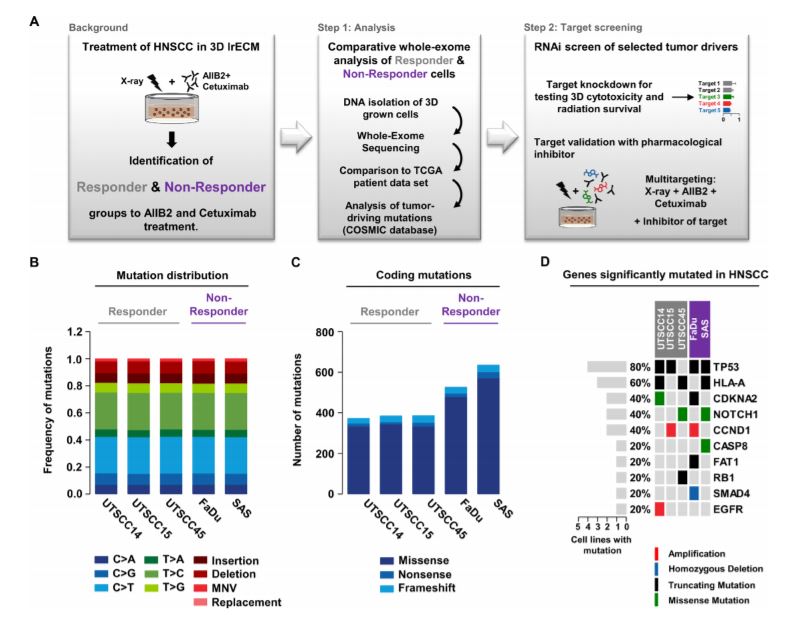
ABSTRACT
Intrinsic and acquired resistances are major obstacles in cancer therapy. Genetic characterization is commonly used to identify predictive or prognostic biomarker signatures and potential cancer targets in samples from therapy-naïve patients. By far less common are such investigations to identify specific, predictive and/or prognostic gene signatures in patients or cancer cells refractory to a specific molecular-targeted intervention. This, however, might have a great value to foster the development of tailored, personalized cancer therapy. Based on our identification of a differential radiosensitization by single and combined β1 integrin (AIIB2) and EGFR (Cetuximab) targeting in more physiological, three-dimensional head and neck squamous cell carcinoma (HNSCC) cell cultures, we performed comparative whole exome sequencing, phosphoproteome analyses and RNAi knockdown screens in responder and nonresponder cell lines. We found a higher rate of gene mutations with putative proteinchanging characteristics in non-responders and different mutational profiles of responders and non-responders. These profiles allow stratification of HNSCC patients and identification of potential targets to address treatment resistance. Consecutively, pharmacological inhibition of mTOR and KEAP1 effectively diminished non-responder insusceptibility to β1 integrin and EGFR targeting for radiosensitization. Our data pinpoint the added value of genetic biomarker identification after selection for cancer subgroup responsiveness to targeted therapies.
این متن کاملا توسط گوگل ترجمه شده است.
چکیده
مقاومت درونی و بدست آمده از موانع عمده در درمان سرطان است. توصیف ژنتیکی به طور معمول برای شناسایی امواج پیش بینی کننده یا پیش آگهی
biomarker و اهداف بالقوه سرطان در نمونه هایی از بیماران مبتلا به درمان نشده است.
تحقیقات به مراتب کمتر رایج برای شناسایی امواج خاص، پیش بینی و / یا پیش آگهی در بیماران یا سلول های سرطانی مقاوم به یک مداخله هدفمند
مولکولی خاص است. این، با این حال، ممکن است ارزش زیادی برای توسعه درمان مبتنی بر سرطان اختصاص داده شده داشته باشد. براساس شناسایی ما از یک حساسیت تشعشع دیفرانسیل توسط یکپارچه و ترکیبی β1 انتگرال (AIIB2) و EGFR (Cetuximab) هدف قرار دادن در سلول های سرطانی کارسینوم سلول سنگفرش سر و گردن (HNSCC) بیشتر فیزیولوژیک، سه بعدی، توالی ترانس آمیز کل، فسفو پروتئوم تجزیه و تحلیل و نمایش RNAi نابودی در خطوط پاسخ دهنده و غیر پاسخ دهنده. ما یک جهش بالاتر از جهش های ژنی با ویژگی های پروتئین تغییر پذیر پروتئین در افراد غیر پاسخ دهنده و پروفیل جهش یافته پاسخ دهنده و غیر پاسخ دهنده یافتیم. این پروفیل ها اجازه می دهد تا طبقه بندی بیماران HNSCC و شناسایی اهداف بالقوه برای پاسخ دادن به مقاومت درمانی باشد. به طور متوالی، مهار دارویی mTOR و KEAP1 به طور قابل توجهی کاهش غیرقابل پاسخگویی به پاسخ دهنده به β1 integrin و هدف EGFR برای حساسیت به رادیوسنتز. داده های ما ارزش افزوده شناسایی ژن biomarker را پس از انتخاب برای واکنش زیربخش سرطان به درمان های هدفمند مشخص می کند.(
پزشکی شخصی)
برای دانلود مقاله کلیک کنید.